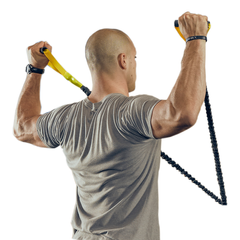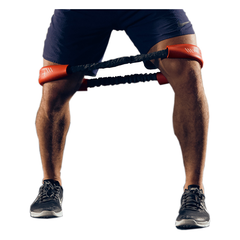Guest post provided by The Strength Continuum
Isometrics produce a muscle contraction but don’t actually move the joint. For example, holding a pair of dumbells with the arms flexed or sitting at the bottom of a squat.
They are common in physical therapy but often overlooked in the gym. Although not as exciting as bench pressing, squatting, or conditioning work, they can be an important part of your program.
The Importance of Isometrics
Isometrics have many applications and reasons to incorporate them into your training program. Here is a short list of reasons why to include them in your training:
Pain Relief
There’s a lot of research on isometrics and their ability to decrease pain. They’ve proven effective in decreasing pain for people dealing with patellar tendinopathy (ref), Achilles tendinopathy (ref), elbow tendinopathy (ref), and rotator cuff tendinopathy (ref).
Positional Stability
For increasing the stability of a joint, the position that it’s in matters. If you don’t have a problem bench pressing but struggle to press overhead, then your stability work should be done overhead. Isometrics help you spend more time in specific positions to improve strength and stability.
Increased Time Under Tension
Building mechanical tension in the muscle is vital to building size and strength. A pause at the end of a rep, or specific isometric exercises, can increase time under tension while accumulating minimal fatigue.
When to Use Isometrics
So, we have the why, but how or when should you to apply them?
Deciding how to implement isometric exercises into a training program largely depends on the athlete’s situation.
Isometrics For Pain or Injury
For anyone dealing with an injury or pain, add in isometrics as part of the warm-up.
Most any activity will get your body warm and prepare you for the upcoming workout. But consciously selecting isometric drills that target your weak links will give you the added bonus of decreasing pain and/or improving the quality of your workout.
Add a few isometric drills specific to the injury or pain as part of a warm-up.
Isometrics For Injury Prevention or Dealing with Deficiencies
For the athlete that’s not currently in pain, but has a history of injury or a problem that limits their performance, add isometrics as ‘fillers.’
Athletes in this situation benefit from targeted isometrics during rest periods of the exercise that gives them problems.
For example, we see a lot of athletes with shoulder pain when pressing overhead. They usually fix the issue during physical therapy with a treatment plan focused on improving posterior rotator cuff strength.
Fast-forward a few months, they’re often back to pressing without a problem. To maintain shoulder health, add something like a banded ‘T’ step-back between sets of overhead press. This adds extra volume and durability to the posterior cuff.
(Check out how to do this exercise here: The Strength Continuum)
As we mentioned before, isometrics are not confined to dealing with pain or injury. For healthy athletes, isometrics can help improve performance.
Feeling weak or uncomfortable at the bottom of the squat? Adding in paused squats to your program might be the solution.
Always missing deadlifts right below the knees? Work on isometrics at that specific angle to improve your strength at that sticking point.
Isometrics are not the sexiest exercises and are usually considered something for rehab until you can get back to the fun stuff in the gym. But an understanding of how to incorporate them into your program will not only keep you healthy over the long haul but can also improve your performance.
Meet The Strength Continuum
The Strength Continuum is a team comprised of a Physical Therapist and a Strength Coach who view Strength and Conditioning Rehabilitation on a continuum as opposed to in isolation.

Stephanie Sfara, PT, DPT, CSCS, is a Doctor of Physical Therapy, graduating from Youngstown State University in 2018, and a Certified Strength and Conditioning Specialist through the NSCA since 2017. Steph attended Armstrong State University in Savannah, Georgia, where she studied Rehabilitation Sciences as her undergraduate degree. While there, she was a scholarship athlete culminating her competitive volleyball career by earning All-American recognitions her senior year in 2014. Since then, she has remained an avid weightlifter and has developed a passion for working with other athletes and active individuals to improve their movement, performance, and health in and out of the gym. Steph actively uses her training knowledge and athletic experiences to improve patient outcomes with optimal loading and injury prevention in the clinic.

Jordan Smuts, MS, ATC, CSCS, is a Certified Athletic Trainer and Strength Coach. He graduated from Indiana University with a Master of Science in Kinesiology with an emphasis in Sports Medicine in 2013, where he was also an Assistant Athletic Trainer with IU athletics. Before that, Jordan attended Franklin College, where he graduated with a degree in Athletic Training while also playing baseball all 4 years. Since then, he has continued to have a passion for lifting and fitness, which ultimately prompted a move from the clinical side to a career in the fitness industry. Jordan uses his personal athletic and training experiences and knowledge of program design and exercise prescription to help his athletes better their performance in and out of the gym.
 Shoulder Packages
Shoulder Packages
 Hip & Core Package
Hip & Core Package
 NEW - Crossover TORQ
NEW - Crossover TORQ
 Bundles
Bundles
 Accessories
Accessories


























